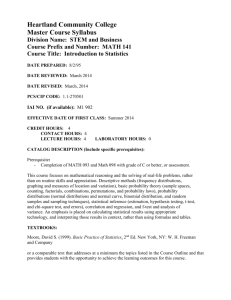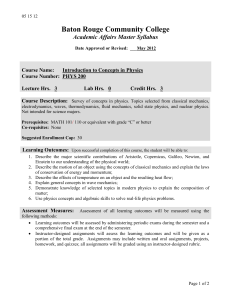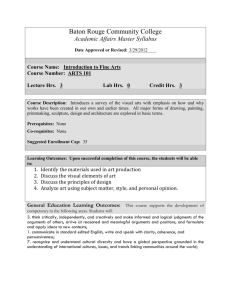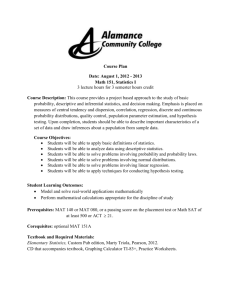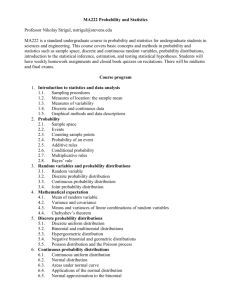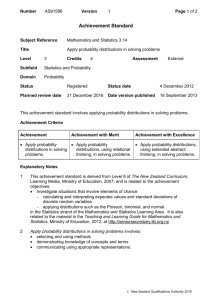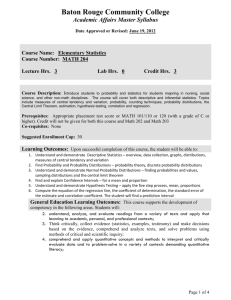MATH 202 - Baton Rouge Community College
advertisement
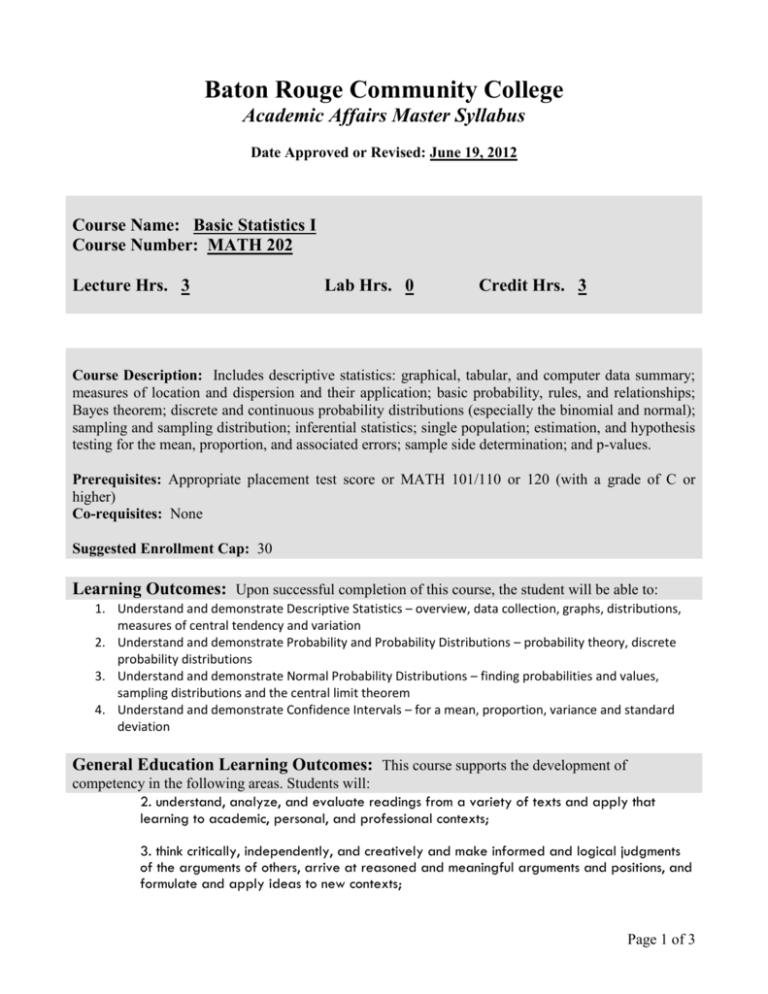
Baton Rouge Community College Academic Affairs Master Syllabus Date Approved or Revised: June 19, 2012 Course Name: Basic Statistics I Course Number: MATH 202 Lecture Hrs. 3 Lab Hrs. 0 Credit Hrs. 3 Course Description: Includes descriptive statistics: graphical, tabular, and computer data summary; measures of location and dispersion and their application; basic probability, rules, and relationships; Bayes theorem; discrete and continuous probability distributions (especially the binomial and normal); sampling and sampling distribution; inferential statistics; single population; estimation, and hypothesis testing for the mean, proportion, and associated errors; sample side determination; and p-values. Prerequisites: Appropriate placement test score or MATH 101/110 or 120 (with a grade of C or higher) Co-requisites: None Suggested Enrollment Cap: 30 Learning Outcomes: Upon successful completion of this course, the student will be able to: 1. Understand and demonstrate Descriptive Statistics – overview, data collection, graphs, distributions, measures of central tendency and variation 2. Understand and demonstrate Probability and Probability Distributions – probability theory, discrete probability distributions 3. Understand and demonstrate Normal Probability Distributions – finding probabilities and values, sampling distributions and the central limit theorem 4. Understand and demonstrate Confidence Intervals – for a mean, proportion, variance and standard deviation General Education Learning Outcomes: This course supports the development of competency in the following areas. Students will: 2. understand, analyze, and evaluate readings from a variety of texts and apply that learning to academic, personal, and professional contexts; 3. think critically, independently, and creatively and make informed and logical judgments of the arguments of others, arrive at reasoned and meaningful arguments and positions, and formulate and apply ideas to new contexts; Page 1 of 3 4. comprehend and apply quantitative concepts and methods to interpret and critically evaluate data and to problem-solve in a variety of contexts demanding quantitative literacy; Assessment Measures: A comprehensive final exam; and Instructor created exams and or homework. Information to be included on the Instructors’ Course Syllabi: Disability Statement: Baton Rouge Community College seeks to meet the needs of its students in many ways. See the Office of Disability Services to receive suggestions for disability statements that should be included in each syllabus. Grading: The College grading policy should be included in the course syllabus. Any special practices should also go here. This should include the instructor’s and/or the department’s policy for make-up work. For example in a speech course, “Speeches not given on due date will receive no grade higher than a sixty” or “Make-up work will not be accepted after the last day of class.” Attendance Policy: Include the overall attendance policy of the college. Instructors may want to add additional information in individual syllabi to meet the needs of their courses. General Policies: Instructors’ policy on the use of things such as beepers and cell phones and/or hand held programmable calculators should be covered in this section. Cheating and Plagiarism: This must be included in all syllabi and should include the penalties for incidents in a given class. Students should have a clear idea of what constitutes cheating in a given course. Safety Concerns: In some programs this may be a major issue. For example, “No student will be allowed in the safety lab without safety glasses.” General statements such as, “Items that may be harmful to one’s self or others should not be brought to class.” Library/ Learning Resources: Since the development of the total person is part of our mission, assignments in the library and/or the Learning Resources Center should be included to assist students in enhancing skills and in using resources. Students should be encouraged to use the library for reading enjoyment as part of lifelong learning. Expanded Course Outline: I. The Nature of Probability and Statistics A. Descriptive and Inferential Statistics Page 2 of 3 B. Variables and Types of Data C. Data Collection and Sampling Techniques D. Observational and Experimental Studies II. Frequency Distributions and Graphs A. Organizing Data B. Histograms, Frequency Polygons, and Ogives C. Other Types of Graphs III. Data Description A. Measures of Central Tendency B. Measures of Variation C. Measures of Position D. Exploratory Data Analysis IV. Counting Techniques A. Tree Diagrams and the Multiplication Rule for Counting B. Permutations and Combinations V. Probability A. Samples Spaces and Probability B. Addition Rules for Probability C. The Multiplication Rules and Conditional Probability D. Probability and Counting Techniques VI. Discrete Probability Distributions A. Probability Distributions B. Mean, Variance, and Expectation C. Binomial Distribution D. Other types of Distributions VII. The Normal Distribution A. Properties of the Normal Distribution B. Standard Normal Distribution C. Applications of the Normal Distribution D. The Central Limit Theorem VIII. Confidence Intervals and Sample Size A. Confidence Intervals for the Means and Sample Size B. Confidence Intervals and Sample Size for Proportions C. Confidence Intervals for Variances and Standard Deviation Page 3 of 3

